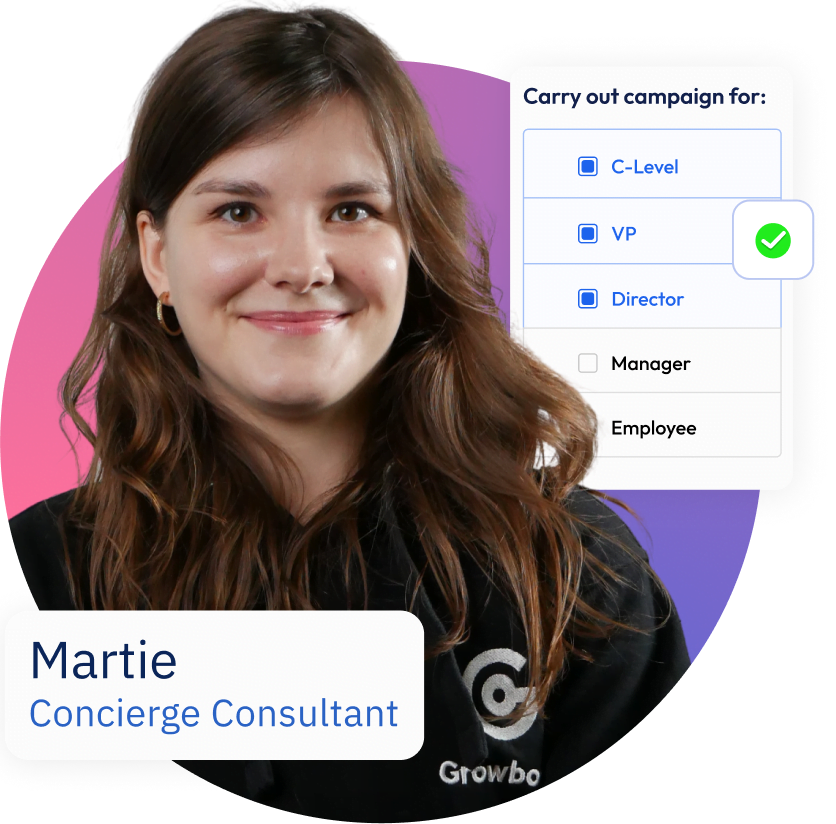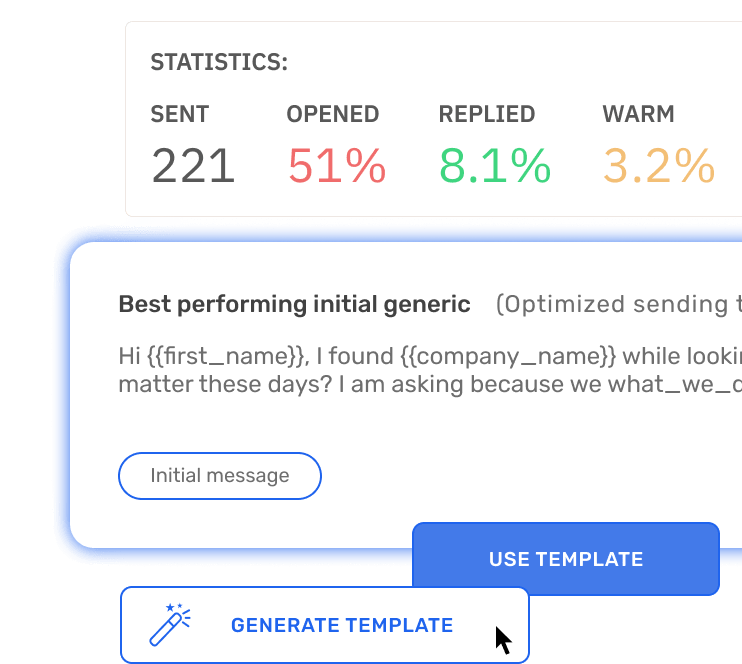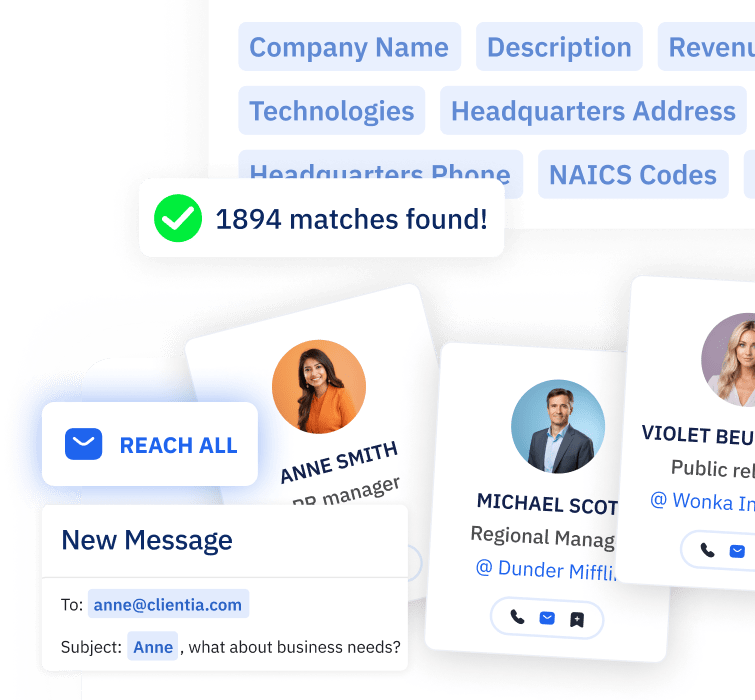Even with the rise of social media, email continues to be a marketing powerhouse. Unlike with Facebook, Twitter, and Instagram, where companies have to fight against algorithms for exposure, email is still the only way to ensure that 100% of your contacts see your email.
According to McKinsey, email marketing is 40x better at winning new customers than social media.
And with email use expected to top 3 billion users within the next two years, it is a forum where nearly every business can create targeted messages for lists of customers and leads that speak directly to their unique needs.
When you are reaching out to a cold lead, it takes the right cold email first lines to see a return on your effort.
For many people, when they sit down to draft a cold outreach opening line, they want to explain who they are.
“Hello, My name is Jane Doe, and I work for ABC Company.”
Unfortunately, not only is this information your lead can find in your signature line, but it wastes the opportunity to spike curiosity, offer value, or establish trust immediately.
A good cold email opening line will do one of these things, and great ones will do all of them.
If you’ve ever wondered how to craft a powerful cold email opening that will catch a lead’s attention and cause them to read further, there are five powerful techniques you should try.
Reach More with Less Effort
Connect with Potential Clients at scale
- AI message generator
- E-mail verification
- Multichannel sequences
- A/B testing
Effective Cold Email Opening Lines You Should Steal
1. Name-drop a common connection
This is a great way to tap into the power of word of mouth without waiting for someone else to send prospects your way. One of the best cold email opening lines immediately turns a prospect warm via a shared connection.
If your first opening sentence mentions someone they know and trust, it ups your credibility and relevance immediately.
Of course, only do this when you have the blessing of the person you’re referencing, but once you have the green light, this tactic is incredibly powerful.
This technique can be used in a lot of different ways – from a solid referral to an opening sentence to discuss how you’ve helped someone else.
Examples: “I have been working with [Connection X] on ….”
“[Connection X] said I should reach out to you.”
2. Mention something you have in common
The technique above doesn’t just have to apply to people. You can use any detail to establish a mutual connection and build rapport. Science has shown that most people tend to like others that remind them of themselves.
Since these are tips for cold email opening lines, you won’t know your connection. Heading to social media is a great way to find these nuggets of information, whether that’s finding out you both went to the same college on a LinkedIn profile or learning that they loved Mean Girls too from a tweet.
Examples: “We have something in common – both are Brown alumni!”
“I wanted to reach out because I noticed that you are also a member of [industry group]….”
3. Throw out a compliment
Everybody loves to know that their work is appreciated or that their accomplishments are noticed. A recent promotion or award is a perfect opening and a genuine compliment to offer your good wishes and possibly spark a conversation.
LinkedIn makes this easy as it updates your contacts’ recent job changes and promotions.
You can also use a recent article, blog post, webinar, or another piece of content to warm up a cold email opening line. Finding something that relates to the product or service you’re selling is the best way to set up the platform to discuss your value offer.
The sky’s the limit here.
Examples: “Your TedX Talk was incredibly inspirational – I really appreciated your thoughts on [topic] in particular.”
“Congratulations on your recent promotion to [title]!”
4. Offer unique insight into the prospect’s problem
This is a great way to craft cold email opening lines that offer immediate value. You can use an interesting statistic or fact about your industry to underline your expertise and your solution.
You can also use high-quality content as well – a thorough whitepaper or a helpful webinar offers value without asking for anything in return. That will get your lead thinking about if you offer this much value for free and how much you could accomplish for a customer.
Examples: “What if I told you that ….”
“I recently read this amazing white paper on [topic] and thought of you.”
5. Try out the Zeigarnik Effect
More commonly known as clickbait, the Zeigarnik Effect is when you raise curiosity, so your lead continues reading. This is named after a psychiatrist that found that humans cannot stand the unfulfilled curiosity.
If you pique a lead’s interest with your cold email opening lines, chances are good your lead will keep reading. That’s why headlines like “You won’t BELIEVE #12!” still work even though they are clichéd. Once someone sees that, they want to open the article and scroll to #12.
Word to the wise, however, unlike clickbait, you don’t want to promise something either in your subject heading or opening line that the rest of the sales email does not deliver.
If your lead clicks into your email to read it and you don’t deliver what you promised, you will hurt any chances you have of making a great first impression.
Example: “Here’s what changed for the better after [name], CEO at [a name of a company]…”
6. Refer to the fact that your prospect started a new job recently
This personal approach is especially valuable as it shows you have done your research and are aware of the prospect’s career start. This way, it catches the prospect’s attention and makes them pay engagement to the cold email first line. Additionally, freshly hired people are usually more likely to invest in different tools and additional services.
Example: “I have noticed you started working at {name of a company} 2 months ago – congrats!”
7. Refer to the fact that your prospects have been working at their companies for a long time
If you really want to conduct effective email marketing, you should make use of all available techniques. This approach in email opening lines is one more good way to show the prospect that you have adequately prepared. Moreover, you are able to not only refer to their work experience but also have an opportunity to start a conversation on a relevant topic and use your intuition about what could work for their employer. When you make it sound more personal and work-related, you have way more chances to draw the recipient’s attention and make your prospects proceed with reading the sales email.
Example: “Noticed you’ve been working at {name of a company} for over 5 years right now – that must have been an exciting time!…”
8. Praise their work – refer to their client
This is one more way to show you have done your homework. Such personalization and individual approach in sales email opening lines get you even closer to reaching success in content promotion. Do not question or underestimate this approach; try putting yourself in your prospect’s shoes. Would you rather appreciate reading the email saying “to whom it may concern”? Exactly!
Example: “Noticed what you did for {a client} – great job!
9. Refer to someone among their colleagues
In plain language, everyone tends to trust contacts having some relation to people they know. This way, prospects will open and read the sales email just because they are curious. In such a subject line, you may include their colleague’s name or position in the opening sentences.
Example: “I was going to reach out to John, your CEO ….”.
10. Mention what the prospect does
When using this personal approach in email opening sentences, you become more distinct and, thus, interesting to a prospect. It suggests that the email will be relevant and shows that you’re reaching out to specific types of companies, not just sending out content promotions to complete strangers.
Example: “Other marketing agencies often experience difficulties with hiring …”
Seek, pick, and reach
Connect with your potential customers
- 180m+ contacts
- Advanced filtering
- Multichannel sequences
- CRM integrations
11. Refer to their recent blog post
This brings you closer to a prospect. Such an opening line seems very personalized and makes your cold emailing unique. Tell them you have read their blog posts, articles, or case studies, point out the fact that you’ve visited their website, and just tell them you do like what they do and how well they do it.
Example: “Just read your last blog post, and it really helped me with {personalization}”
12. Mention you invited the prospect on the LinkedIn page
We have decided to share with you this unique jumping-off point. It works efficiently if you send a Linkedin invitation before sending the initial email. Moreover, it is a great link building and increases the reply rates. Remember that multichannel campaigns work truly well nowadays.
Example: “I sent you a LinkedIn invitation yesterday – hope to connect there as well!” or “Thanks for accepting my LinkedIn invitation!”
13. A common problem for your target audience
A shared pain-in-the-neck can easily unite people. It makes email relevant to your prospect as you refer to pains you’ve heard from people in similar positions. If you get the bother right, they’ll be engaged right away and will read the whole email for sure.
Example: “From what I’ve heard from other sales directors …”
14. Start with an engaging statistics
To put it another way, if the statistic you mention is connected with a prospect’s expertise, it should definitely catch their attention. It works out especially great if this statistic is related to a recent trend or issue in the same industry.
Example: “67% of information covered during an, e.g., EHS onboarding workshop will be forgotten within a week.”
15. Ask if they experience a similar challenge
All people receive stacks of cold emails daily. However, trust us, nothing works better than being relevant to the prospect’s headache. If you manage to define their challenge well, they will be intrigued by such an opening line, and you have great chances of being noticed.
Example: “Are you having difficulties with finding experienced IT candidates?”
16. Refer to the recent company news
This approach shows you’re up-to-date with their situation, and it suggests you might have something that could help them in this specific moment. To put it another way, the prospect gets a gist that you are into their company just from reading such email opening sentences.
Example: “I saw you’ve just raised the recent funding of Series B for…”
17. Refer to the problem company had recently
In terms of professional emails, it shows you, as cold emailers, are following the company and might be able to help them. In addition, in such a case, the urgency on the prospect side is high, so it might be much easier to get someone’s attention and reply. Always remember that personification is the key!
Example: “I have seen that your website was down for a couple of hours last week and figured that you might need to …”
18. Looking for the right person to talk to
Let’s dive a bit into this one. This tip is especially useful while targeting CEOs, owners, or founders of small to medium-sized businesses. Such people are usually open to pointing you in the right direction. Likewise, it’s not just another hard sales pitch thrown at their face. So, once they connect you with the appropriate person in their team, it’s easier to get them on a call and follow up on the promotion.
Example: “Who’s the best person at {name of a company} to discuss … ?”
19. Be accurate about what your prospects do
Speaking of the most common ways of getting closer to a prospect, you can use automated personalization in the email greeting, like adding industry to the business email. Even so, there are other ways you could add a more specific description if you do the latest research on a prospect. That makes you stand out from the crowd and increases the chance of getting a reply.
Example: “I have just seen your sales automation platform – looks sleek!”
Reach More with Less Effort
Connect with Potential Clients at scale
- AI message generator
- E-mail verification
- Multichannel sequences
- A/B testing
20. Refer to the conversation you had
One more method to boost your chances! If you’ve already been in touch with this prospect, e.g., they replied to your email, or you had a conversation, you should definitely mention it! It automatically makes your email more relevant and appealing. Moreover, it establishes trust between you.
Example: “Last May we spoke about {service}, and I’m coming back because …”
21. Refer to the initial interest of a prospect
Email marketing has its ups and downs. You do remember the times you were ignored. But! Keep your chin up. If someone wanted to get on a call with you but then ghosted you, you shouldn’t give up. Just get back to them and try to get them on board one more time. No matter what, win the prospect’s interest over! Referring to the fact that someone has already been interested helps a lot.
Example: “A few weeks back, you were interested in learning more about our {offer}, but we didn’t manage actually to talk. So …”
22. Use your prospect’s competitor
This cold email opening line contrasts with others a bit. However, just simply mentioning a competitor will always catch a prospect’s attention. To pinpoint, it builds some kind of urgency. There’s one thing you should keep in mind -the key is to keep it neutral. Be careful because if you use it to scare someone off, it will backfire right back at you!
Example: “Have you seen how {competitor} use {offer}?
23. Market shift
Any change in the market can be used for your benefit. When the situation changes (e.g., pandemic), you can use it to your advantage. Referring to such a situation makes your email more relevant and up-to-date, which always serves you well and helps you bring a prospect closer. This’s just simple as that!
Example: “Are you planning to adjust to the current situation? The pandemic has changed the way we all do business, so ….”
24. Their colleagues/friends
This approach to sales email opening lines is similar to the one described earlier. When you mention such a person in the email greeting, it will always draw a prospect’s attention. Howbeit, make sure that this colleague or mutual friend you’re referring to has agreed to that. Otherwise, it might backlash, so be careful.
Example: “I’m reaching out because {colleague}, whom I help with {service}, has told me you might be interested … “
25. Add some context
This tip works well, but it can be used only for follow-up cold emails. After you sent the first one, which was rather descriptive and long, you should send a shorter one, more of a reminder rather than an actual email. Commonly, we recommend using the second email in the cadence as a reliable solution to tell more about the meeting we’re inviting our prospects to and what they can expect.
Example: “Just to add some context – it won’t fall into the same trap of a feature dump demo, we’ll …”
26. Any thoughts?
You may notice that this cold email opening line also spans follow-up sales emails. This follow-up example is an opening line and call-to-action as well. “Any thoughts” is the whole email. Seems too good to be true, but it really works.
Example: “Any thoughts?”
27. Creating a real-time impression
Let’s face it. Most of your prospects know your outreach emails are automated. So, what could create an impression of the fact that sending these cold emails in real-time is referring to something that happened after the cadence had been started? Let’s buckle down that.
Example: “Yesterday, I got a couple of answers saying – “not interested, we already have something in place,” and thought you might have felt the same. Just to clarify {value_proposition} …”
28. Refer to the prospect’s activity on LinkedIn/Twitter
One more personification cold email opening line. Still doubting whether it works? Well, if you refer to your prospect’s article or post, it shows, again, you’ve done your research. People like to be acknowledged, and they’re usually bonded to the content they created. So bringing it up can only help.
Example: “I have read your article on managing salespeople and found it really helpful in my daily routine!”
29. Break-up email
You couldn’t agree more that sales are challenging work. When it comes to email opening lines, break-up ones are used but not in all cases. They work if you truly have established a relationship with someone, e.g., had a call with them. Usually, it’s 3-6 emails or calls. Although break-up emails shouldn’t and can’t be used in every cadence, in some cases, it’s good to include them into your sequence. It basically guarantees a couple of warm leads.
Example: “Just want to check in one last time and make sure I haven’t overstepped your bounds. Given your initial interest in our solution ….”
30. Refer to the team of your prospect
You can easily hit the target when the tip is used properly. If you’re targeting managers, directors, vice-presidents, etc., they usually manage a team, so they are those experts you need. That being said, you can mention the names of their direct subordinates, you can note how big this team is, and more. These all hints catch attention because they are relevant to your prospect.
Example: “I was going to reach out to John, your CEO, but have realized you’re a better person to talk to as you’re managing a team of over 10 recruiters.”
31. Emailing your ex-customers
Here’s one more alternative. If someone used to work with you or used your tool and changed job, you should definitely get back in touch with them. Such personalization is very strong and usually guarantees very high reply rates, especially if they reacted to previous emails. You may see something great happening!
Example: “I don’t know if you remember using our tool at {name of the previous company}. Wanted to check up on you and ask if you face any challenges at {name of a new company} that we could help you with.”
32. Social proof
This one is an ideal follow-up message. It’s a nice bump if you choose an appropriate testimonial. You can mention some mutual connections (especially people with busy schedules who receive dozens of sales pitches from complete randos all the time), highlight some professional credentials, add convincing data, name-drop publications or prove that what you do really works. No matter what, it should fit into the persona, e.g., the CEO should get a different quote than their sales reps or other subordinates. Check it out yourself, and you’ll see it works, and it will give you some replies.
Example: “One of our freshest customers, Penny, wrote: {testimonial}”
33. Refer to the team structure
A good way to start a conversation. It’s important, as the team structure might influence provided someone is interested in your offer. For example, if you offer staffing services, you should probably reach out to companies with no or small HR departments. When all is said and done, you should mention this fact in the cold email, as this is true and relevant to your prospect.
Example: “I have checked your line-up and noticed you don’t have anyone in charge of your recruitment services …”
34. Refer to when the company was founded
Quick info – well-established businesses usually have more referrals than those that have just started. That is why sometimes the age of the company influences their situation. Don’t pass by this approach. Use that!
Example: “I have noticed you started {a name of a company} 4 years ago …”
35. Use numbers!
When it comes to follow-ups, sometimes you don’t have to tell the whole story from the beginning, you can just add a little piece of information that will convince your prospect to move forward. In such a case, a few stats and figures are more than useful. But before sharing them, you have to be open to emails like this. Numbers like accuracy!
Example: Just to give you a great idea in numbers: on average, our customers …”
36. Refer to a prospect’s company’s profile
If you mention that you have a solution exactly for the companies that you’re cold emailing, it makes it more relevant and actionable for prospects. Moreover, this could help you a lot to open up the discussion between the two of you and show how your services might be able to aid and abet them.
Example: “I have noticed {a name of a company} while looking for marketing agencies between 5 to 20 employees with no sales team.”
37. Add some humor
A pinch of humor is always good! It makes the whole cadence more natural and delivers really high reply rates. Of course, you can come up with your ideas, but here’s one of ours. A little bit of funny email can help you filter through the tons of generic emails and spark some mutual connection with a prospect.
Example: “Although I’m looking for a “yes,” I’m not asking you to marry me.”
38. Open position
The magic consists in using a genuinely relevant subject line. Nevertheless, if a manager is looking for someone to join the team, they clearly have a need that has to be jammed. If you refer to that and are able to fill that gap, you’ll get the interest and increased reply rates.
Example: “Noticed you’re looking for a new recruiter to join your team …”
Make it personal
Finally, when you are writing professional emails to prospects, it’s important to tailor every email to each prospect to build strong cold email campaigns. Each of these tricks relies on you tapping into a common ground that you have with a prospect.
Even if it isn’t immediately obvious, there is likely something you share with a lead you can use to break the ice.
Conclusions
If your company is looking to expand its email outreach, marketing, and ROI with fresh leads that fit the image of your company’s ideal customer, consider Growbots.
From finding target markets to crafting sales campaigns, Growbots makes email marketing easy and effective.
Do you have a trick for writing first lines for cold emails that work? Let us know in the comments.

























